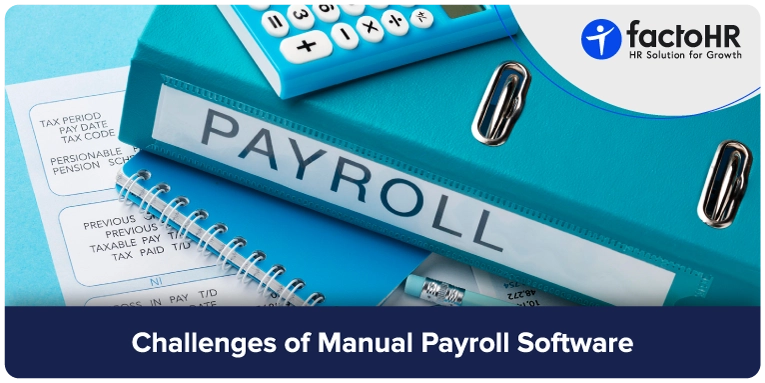What Are the Challenges of Manual Payroll?

Table of Contents
In today’s world, using outdated manual payroll is like trying to send a letter by carrier pigeon. It’s slow, inefficient, and will not yield your desired positive result. However, the output will consistently be inefficient for businesses of all sizes.
Manual payroll is time-consuming. It eats up the precious hours that could be better spent focusing on growth and innovation. Plus, It’s a magnet for errors. Missed calculations can escalate into financial agony for both you and your employees. This is one of the most common challenges.
This blog will address the challenges of manual payroll processing. It will also discuss automated alternatives.

What Is Manual Payroll?
The term “manual payroll” can seem contradictory because payroll software is designed to automate tasks and save time. Manual payroll means calculating and distributing employee pay without using software, and it’s considered an outdated method.
In manual payroll, human resources or accounting staff do everything by hand. This would include employee hours, regular pay and overtime calculations, various deductions and withholdings, and paycheck or direct deposit generation.
Spreadsheets and essential accounting software can assist with calculations. However, they still need manual entry, manipulation, and error checking.
Challenges of Manual Payroll
The Human Error Factor
Manual payroll procedures rely on human input, which can lead to errors. Errors occur in a variety of ways:
Data Entry Errors
Data entry errors include typing errors, transposed numbers, and no entry for hours worked, pay rates, or deductions. A misplaced decimal point can significantly impact an employee’s paycheck. For example, listing 30 hours instead of 40 can cause a significant pay error. Missing 10 hours of wages due to that oversight would be very costly.
Miscalculations
Payroll calculations can be complex due to different pay rates and overtime rules. They also involve various deductions. A manual error in calculating taxes, withholding amounts, or gross pay may lead to underpayment or overpayment.
An overpayment may seem like a good thing when it occurs, but it creates a headache during tax season when the employee must pay the IRS back. Underpayment may lead to serious trouble, unhappy employees, and a potential lawsuit against the business owners.
Keeping Up With the Law
Payroll regulations are ever-changing, including new tax laws, changes to the minimum wage, and updated leave policies. Tracking these changes can significantly challenge businesses relying on manual salary process.
The Compliance Maze
Manually keeping up with laws can be laborious and time-consuming. Missing important updates or misinterpreting regulations may lead to labor and tax laws non-compliance.
Cost of Non-Compliance
The penalties for non-compliance may be severe. According to the law, any non-complying business is subject to significant fines, penalties, and even litigation. Such costs may exceed any apparent cost savings from manual salary processing.
Time Tracking Troubles
The challenges of manual payroll include accurately tracking employees’ time.
Manual Tracking Inefficiency
Traditional paper timesheets or punch card methods for tracking time are highly laborious and inaccurate. Sometimes, employees must remember to punch in or out, or they may record breaks and overtime incorrectly. Inaccuracies mean more work for HR and payroll staff, who must correct the problems.
Leave Management Headaches
Manually recording paid time off, sick leave, and other types of leave can quickly become a logistic headache. Tracking every employee’s balance, approval, and accrual is exhausting, especially if your workforce grows. Complicated payroll issues can delay processing for a long time. This frustrates employees who don’t know how much leave they have left.
Employee Productivity and Morale
Manual payroll processes always affect employee productivity and morale.
The Burden of Data Entry
Manually entering time data or payroll forms takes up much time for employees who need to do it. This time would otherwise go toward core job duties. Moreover, repetitive data entry might get mundanely tiring, and thus, it demotivates employees.
Security Concerns
Manual payroll often stores sensitive employee information, such as social security numbers and bank account details, on paper or in unsecured spreadsheets. Such storage methods can be risky, as this kind of information is highly susceptible to theft, loss, and unauthorized access.
Data breaches
Paper records and unsecured spreadsheets are potential goldmines for illegal access. Physical breaches, like losing a file or laptop, can expose sensitive information. Digital breaches, such as hacking, also put this information at risk.

The Impact of Inaccurate Payroll
Something as simple as inaccurate payroll can cause problems for the employer and the employee. We will explain how manual payroll errors harm employee morale, legal compliance, and business operations.
Demoralized Workforce
When workers receive their paychecks and are either underpaid or overpaid, it causes frustration and stress. Underpayment means financial hardship, which an employee feels by not being able to provide basic needs. Overpayment can lead to deductions or clawbacks from future payments. This causes anxiety and undermines trust in the company’s financial management.
In both cases, morale drops, reducing productivity and increasing absenteeism. This leads to higher employee turnover.
Compliance Risks and Legal Consequences
Any payroll error invites legal non-compliance. Underpayment could result in wage theft claims, including expensive lawsuits and fines. Overpayment creates tax and accounting headaches. The wrong deductions or withholdings may trigger penalties from tax authorities. Such legal ramifications can hurt the company financially and reputation-wise.
Operational Inefficiencies
Payroll reconciliation with manual processes connected to troubleshooting and remediation eats into precious hours and resultant productive resources. Paperwork and phone calls burden the HR department with resolving discrepancies. This distracts them from focusing on strategic initiatives. It also affects their ability to manage employee relations effectively.
Paperwork and phone calls overload the HR department with resolving issues. This distracts them from strategic initiatives and managing employee relations. A sound payroll system builds trust and boosts morale. It also frees HR to focus on other tasks, improving the work environment.

Benefits of Switching to Payroll Software
Imagine smooth, error-free payroll processing that takes a lot less time. That is the real world brought to all-sized businesses by payroll software. In synchrony, it automates annoying tasks and ensures compliance, opening the way to a significant number of benefits:
Increased Accuracy and Compliance
It removes the scope of human errors in data entry and related calculations. It has built-in features that update your business on changing tax laws and provisions.
Increased Efficiency and Productivity
The software computerizes repetitive tasks such as calculating deductions, generating reports, and distributing paychecks. This frees HR and payroll staff time to deal with more strategic initiatives. In addition, it streamlines employees’ time tracking and leave management processes.
Security
It provides robust protection for sensitive employee information. Encryption of storage and access controls helps prevent information breaches.
Reduced Costs
While payroll software may require a one-time investment, the long-run cost savings are enormous. Reduced errors, improved efficiency, and minimized compliance risks result in lower payroll processing costs.
Better Satisfaction
Correct and on-time paychecks are essential to employees. The payroll system allows employees to be paid on time and removes frustration caused by errors. Simplified time tracking and leave management also create a more positive employee experience.
Conclusion
We’ve explored the challenges of a manual payroll. It causes human errors and compliance issues. It also leads to inefficient time tracking and security risks. These problems can harm business operations and employee satisfaction.
High-powered payroll system streamlines processes, ensures accuracy, and enhances security. You’ll increase efficiency, lower costs, and have happier employees.

Frequently Asked Questions
1. Is Payroll Software Hard to Implement?
Most payroll software providers have ensured that their products are user-friendly and have great support resources. Proper planning for the transition from manual payroll should mean no significant issues. Many providers will offer training and ongoing customer support to ensure successful implementation.
2. Our HR Team Is Small and Efficient. Can’t They Handle Manual Payroll?
While a strong HR team can manage payroll manually, it becomes an enormously time-consuming burden in a growing company. Payroll software handles repetitive tasks automatically, letting HR staff focus on strategic work, such as employee relations and talent management.
3. How Can Payroll Software Improve Employee Satisfaction?
It eases time tracking and leaves management, eliminating employee frustration and confusion. By making payroll more manageable, you can show you care about a positive work environment.
4. We Have a Unique Payroll Structure With Bonuses and Commissions. Can the Payroll System Handle That?
Most payroll solutions are highly customizable to accommodate a variety of pay structures, deductions, and benefits. If you plan to outsource, discuss your needs with the software provider. Verify that their software meets your company’s specific payroll requirements. This will help your business work well.
Grow your business with factoHR today
Focus on the significant decision-making tasks, transfer all your common repetitive HR tasks to factoHR and see the things falling into their place.

© 2026 Copyright factoHR


